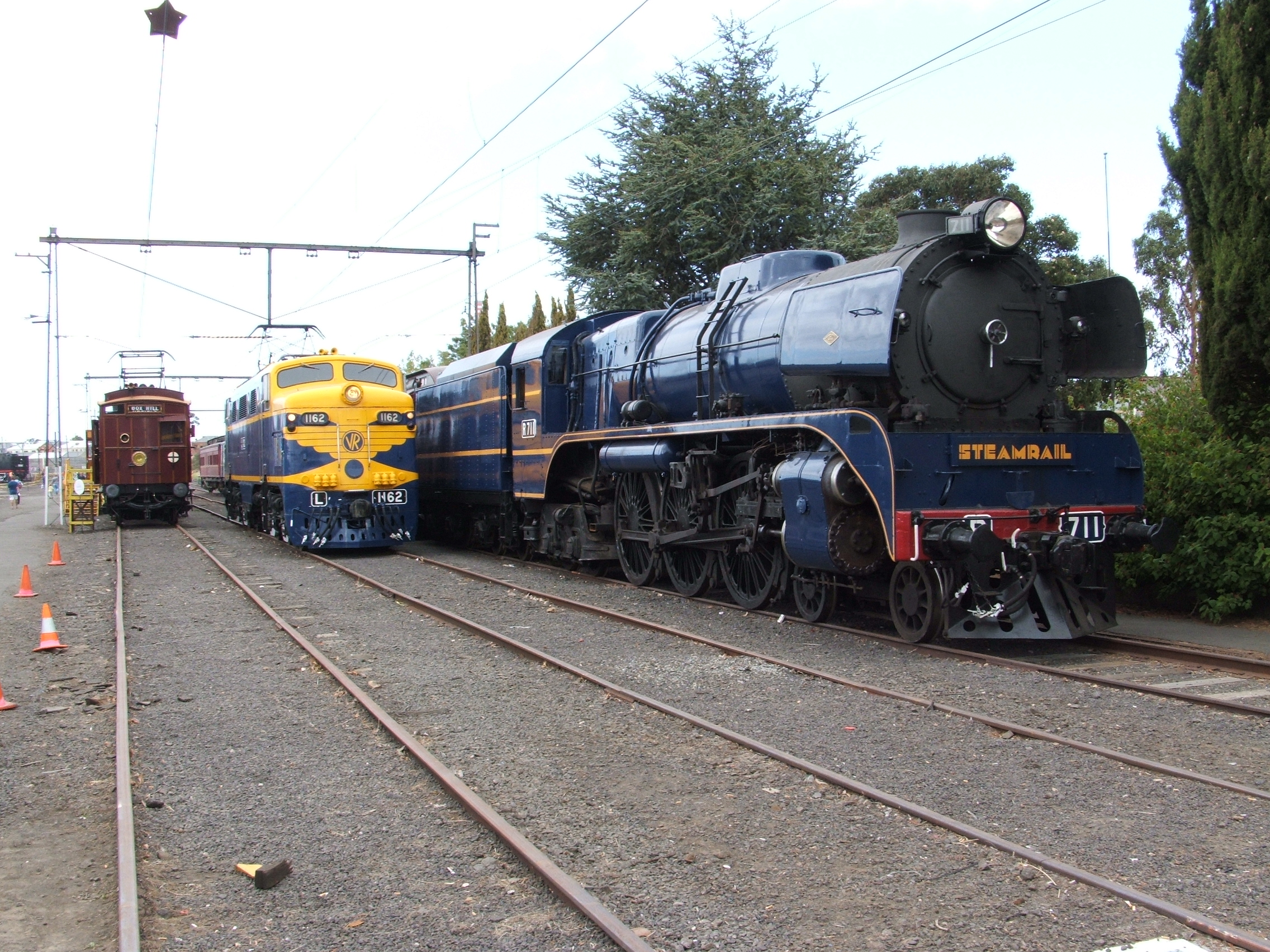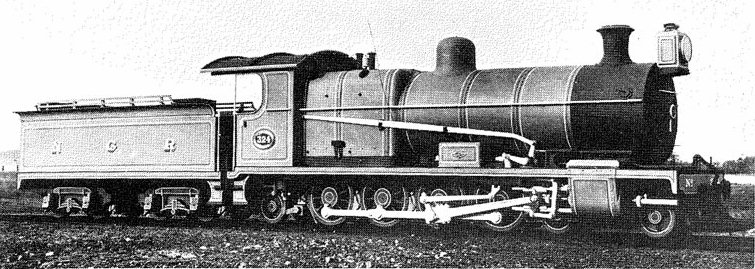|
Victorian Railways H Class
The Victorian Railways H class is a heavy express passenger steam locomotive operated by the Victorian Railways from 1941 to 1958. Intended to eliminate the use of double heading Victorian Railways A2 class, A2 class locomotives on ''The Overland'' services on the steeply graded Serviceton railway line, Western line to Adelaide railway station, Adelaide, wartime restrictions led to only one locomotive being built. Nicknamed ''Heavy Harry'', H220 was the largest locomotive ever built in Australia and the largest non-articulated steam locomotive to run on Australian railways. History By 1923, the A2 class 4-6-0 locomotives, which dated back to 1907, were frequently double-heading on interstate expresses to Serviceton and Albury railway station, Albury, because increasing traffic saw loads exceed the eight-car maximum of a single A2. The Victorian Railways#Management, Victorian Railways Commissioners recommended considerably more powerful locomotives, that could haul trains of up ... [...More Info...] [...Related Items...] OR: [Wikipedia] [Google] [Baidu] |
Newport Workshops
The Newport Railway Workshops is a facility in the Melbourne suburb of Newport, Victoria, Newport, Australia, that builds, maintains and refurbishes Rolling stock, railway rollingstock. It is located between the Williamstown railway line, Williamstown and Werribee railway lines. History Plans for a workshop at Newport started in the 1860s, to replace the temporary Williamstown Workshops but nothing came of it. It was not until 1880 that work began, when the Victorian Railways purchased annexes used at the Melbourne International Exhibition (1880), 1880 Melbourne Exhibition and erected one of them at Newport, naming it the Newport Carriage Workshops when it began operation in 1882. Construction of the permanent workshops commenced in 1884, and was completed in 1889. Although the earlier carriage workshop closed at this time, it reopened in 1895 to manufacture signal equipment. The first Railroad car, carriages built by the workshops were completed in 1889, but early locomotives w ... [...More Info...] [...Related Items...] OR: [Wikipedia] [Google] [Baidu] |
Victorian Railways S Class
The Victorian Railways S class was a class of 4-6-2 express passenger steam locomotive operated by the Victorian Railways (VR) in Australia between 1928 and 1954. Built when the VR was at its zenith and assigned to haul the Rail gauge in Australia, broad gauge-leg of its Melbourne to Sydney interstate express passenger services, the S class remained the VR's most prestigious locomotive class until the advent of diesel electric locomotives in the early 1950s. They were the first 4-6-2, Pacific-type locomotives on the VR, as well as its first 3-cylinder locomotive type. Renowned for their power and speed, in the ten years that followed their introduction the running time of the premier Sydney express service they operated was progressively reduced by one and a half hours. These service improvements culminated in 1937 with the replacement of the ''Sydney Limited'' with the Art Deco streamliner ''Spirit of Progress'', and the S class locomotives were fitted with streamlined ... [...More Info...] [...Related Items...] OR: [Wikipedia] [Google] [Baidu] |
Adhesion Railway
An adhesion railway relies on adhesion traction to move the train, and is the most widespread and common type of railway in the world. Adhesion traction is the friction between the drive wheels and the steel rail. Since the vast majority of railways are adhesion railways, the term ''adhesion railway'' is used only when it is necessary to distinguish adhesion railways from railways moved by other means, such as by a stationary engine pulling on a funicular, cable attached to the cars or by a pinion meshing with a rack railway, rack. The friction between the wheels and rails occurs in the wheel–rail interface or contact patch. The traction force, the braking forces and the centering forces all contribute to stable running. However, running friction increases costs, due to higher fuel consumption and increased maintenance needed to address fatigue (material), fatigue damage and wear on rail heads and on the wheel rims and rail movement from traction and braking forces. Variation ... [...More Info...] [...Related Items...] OR: [Wikipedia] [Google] [Baidu] |
H220motion3
H, or h, is the eighth letter of the Latin alphabet, used in the modern English alphabet, including the alphabets of other western European languages and others worldwide. Its name in English is ''aitch'' (pronounced , plural ''aitches''), or regionally ''haitch'' (pronounced , plural ''haitches'')''.''"H" ''Oxford English Dictionary,'' 2nd edition (1989); ''Merriam-Webster's Third New International Dictionary of the English Language, Unabridged'' (1993); "aitch" or "haitch", op. cit. Name English For most English speakers, the name for the letter is pronounced as and spelled "aitch" or occasionally "eitch". The pronunciation and the associated spelling "haitch" are often considered to be h-adding and are considered non-standard in England. It is, however, a feature of Hiberno-English, and occurs sporadically in various other dialects. The perceived name of the letter affects the choice of indefinite article before initialisms beginning with H: for example "an H-bomb" ... [...More Info...] [...Related Items...] OR: [Wikipedia] [Google] [Baidu] |
South Australian Railways 500 Class (steam)
The South Australian Railways 500 class was a class of 4-8-2 steam locomotives operated by the South Australian Railways. The locomotives were rebuilt in 1928, when booster engines were installed, becoming the 500B class with a wheel arrangement of 4-8-4 and a tractive effort of . The 500B class were the second-most-powerful non-articulated steam locomotives to operate in Australia, behind the NSWGR D57 4-8-2. History The 500 class were part of larger order for 30 steam locomotives placed with Armstrong Whitworth, England, in 1924, as part of the rehabilitation of the state's rail system being overseen by Railways Commissioner William Webb. They replaced the Rx and S class locomotives, many dating back to 1894, that were still performing mainline duties, meaning that double and even triple heading was common. All ten 500-class locomotives arrived in Adelaide in 1926, and entered service on the Adelaide to Wolseley line as far as Tailem Bend. All were named after notable So ... [...More Info...] [...Related Items...] OR: [Wikipedia] [Google] [Baidu] |
New South Wales D57 Class Locomotive
The New South Wales D57 class is a class of 4-8-2 steam locomotives built by Clyde Engineering for the New South Wales Government Railways in Australia. The tenders were built by Mort's Dock & Engineering Company. History The locomotives were among the heaviest in Australia with a axle load. This factor and their width restricted their sphere of operation to Thirroul on the Illawarra line, Wallerawang on the Main Western line and Junee on the Main South line. Due to the immense size of the firebox, they could not be hand-fired and had to use a mechanical stoker, thus becoming the first New South Wales locomotive class to use a mechanical stoker. They were later followed by the 58 class and the 60 class. They were not permitted to operate on the Main Northern line due to load limitations on some bridges and a tighter loading gauge. They had the highest tractive effort of any non-articulated steam locomotives used in Australia and were of approximately equal capabi ... [...More Info...] [...Related Items...] OR: [Wikipedia] [Google] [Baidu] |
Australia
Australia, officially the Commonwealth of Australia, is a country comprising mainland Australia, the mainland of the Australia (continent), Australian continent, the island of Tasmania and list of islands of Australia, numerous smaller islands. It has a total area of , making it the list of countries and dependencies by area, sixth-largest country in the world and the largest in Oceania. Australia is the world's flattest and driest inhabited continent. It is a megadiverse countries, megadiverse country, and its size gives it a wide variety of landscapes and Climate of Australia, climates including deserts of Australia, deserts in the Outback, interior and forests of Australia, tropical rainforests along the Eastern states of Australia, coast. The ancestors of Aboriginal Australians began arriving from south-east Asia 50,000 to 65,000 years ago, during the Last Glacial Period, last glacial period. By the time of British settlement, Aboriginal Australians spoke 250 distinct l ... [...More Info...] [...Related Items...] OR: [Wikipedia] [Google] [Baidu] |
Loading Gauge
A loading gauge is a diagram or physical structure that defines the maximum height and width dimensions in railway vehicles and their loads. Their purpose is to ensure that rail vehicles can pass safely through tunnels and under bridges, and keep clear of platforms, trackside buildings and structures. Classification systems vary between different countries, and loading gauges may vary across a network, even if the track gauge is uniform. The term loading gauge can also be applied to the maximum size of road vehicles in relation to tunnels, overpasses and bridges, and doors into automobile repair shops, bus garages, filling stations, residential garages, multi-storey car parks and warehouses. A related but separate gauge is the structure gauge, which sets limits to the extent that bridges, tunnels and other infrastructure can encroach on rail vehicles. The difference between these two gauges is called the clearance. The specified amount of clearance makes allowance for ... [...More Info...] [...Related Items...] OR: [Wikipedia] [Google] [Baidu] |
4-8-2
Under the Whyte notation for the classification of steam locomotives, represents the wheel arrangement of four leading wheels, eight powered and coupled driving wheels and two trailing wheels. This type of steam locomotive is commonly known as the Mountain type, though the New York Central Railroad used the name Mohawk for their 4-8-2s. Overview The Colony of Natal in South Africa and New Zealand were innovators of the Mountain wheel arrangement. The Natal Government Railways (NGR) placed in service the first tank engines with the 4-8-2 arrangement, and the NGR was also first to modify tender locomotives to use a 4-8-2 wheel arrangement. The New Zealand Railways Department (NZR) introduced the first tender locomotives designed and built as 4-8-2. In 1888, the Natal Government Railways placed the first five of its eventual one hundred Class D tank locomotives in service. The locomotive was designed by William Milne, the locomotive superintendent of the NGR from 1877 to 1 ... [...More Info...] [...Related Items...] OR: [Wikipedia] [Google] [Baidu] |
Ballarat Railway Station
Ballarat railway station is a regional railway station located on the Ararat and Mildura railway lines. It serves the city of Ballarat, Victoria, Australia, and opened on 11 April 1862 as Ballarat West. It gained its current name in 1865. The extensive building complex is listed on the Victorian Heritage Register as being of "historical, architectural, social and technological significance" to the State of Victoria. Significant 19th-century heritage features listed on the Register include the station's signal boxes; the goods shed, being the only one in Victoria built of bluestone; the clock tower, with Ballarat being one of only four 19th-century railway station in Australia to prominently feature one, although the clock itself was not installed until almost a century later in 1984; and the train shed, with Ballarat being one of only three 19th-century railway stations in Australia retaining their original train shed. The replica interlocked mechanical gates were damaged ... [...More Info...] [...Related Items...] OR: [Wikipedia] [Google] [Baidu] |





